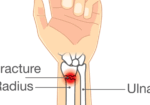Should we still be immobilizing the thumb in scaphoid fractures, or is a wrist-only cast just as effective?
Filed under Orthoses
Article:
Harper, K. J., Rees, Y., Tan, N. X., Li, H., Fonseca, E. A., Quach, P. G., Lee, G. S., Brayshaw, J.
R., & McGarry, S. (2025). Determining the success of clinical outcomes for thumb
immobilization compared to no thumb immobilization in adult non-displaced, non-
surgically managed scaphoid fractures: A systematic review. Hong Kong journal of
occupational therapy.
The Skinny:
This study is a systematic review that evaluated the clinical outcomes of leaving the thumb free
versus including the thumb in cast immobilization for adults with non-displaced scaphoid
fractures treated conservatively. The measures being evaluated in this study included fracture
healing, wrist movement, hand function, pain, grip strength, and scaphoid stability.
In The Weeds:
The authors reviewed available literature from multiple major databases such as Embase,
Medline, Scopus, and Web of Science as their primary search strategy. Studies were included in
this review if they included participants who were 16 years or older, if fractures were managed
conservatively using immobilization and if the studies assessed one of the following outcomes…
- Fracture union
- Hand function
- Wrist range of motion
- Pain
- Grip Strength
- Scaphoid stability
The six studies selected included four randomized controlled trials and two single-group pre-post
design studies. Key findings: In the included studies, there was no difference in healing rates
between casts that immobilized the thumb and those that left it free, with radiological
evidence showing similar union of the bone. Pain reduction was also similar, as no
consistent benefit was seen from adding thumb immobilization. Functional outcomes
measured by tools such as the PRWE and DASH showed no significant differences, with
thumb-free casts supporting recovery just as much. Grip strength at follow-up was the
same between groups, and wrist range of motion recovered to the same extent, with
thumb-free casts offering added comfort and practicality during daily activities. Scaphoid
stability did not improve with thumb immobilization, and overall patient satisfaction
tended to be higher when the thumb was left free.

Bringing it Home:
The findings of this review show there is insufficient evidence to support the inclusion of the
thumb during cast immobilization for non-displaced scaphoid fractures in adults. Leaving the
thumb free from a wrist cast can be as effective while being a more functional form of
immobilization for patients. Clinicians might consider wrist-only casts for non-displaced
scaphoid fractures for enhancing clinical outcome and patient satisfaction.
Rating: 4/5
The strengths of this systematic review include the study design giving it a high level of
evidence, the inclusion of randomized controlled trials, and its selection of clinically relevant
outcomes such as function and pain. The selected studies relevance to the research questions and
the exclusion of non-validated outcome measures greatly strengthens the conclusions of the
study. This study was limited by its small number of studies included and the high variability in
study design across the six articles. The conclusions of this study are also difficult to generalize
since the study only examined non-displaced fractures of the scaphoid. The age range also limits
generalizability for pediatric populations.
2 Comments
Leave a Comment
More To Read
Effects of different stretching techniques for improving joint range of motion.
Reference: Oba, K., Samukawa, M., Abe, Y., Suzuki, Y., Komatsuzaki, M., Kasahara, S., Ishida, T., & Tohyama, H. (2021). Effects of Intermittent and Continuous Static Stretching on Range of Motion and Musculotendinous Viscoelastic Properties Based on a Duration-Matched Protocol. International journal of environmental research and public health, 18(20), 10632. https://doi-org.libproxy.nau.edu/10.3390/ijerph182010632 The Skinny: This study used a cross-over…
Read MorePros and Cons of Cortisone Injections
By: Shruti Jani Patients will often times ask the therapist their opinion on cortisone injections. Cortisone injections can be very helpful and significantly reduce inflammation, however, some therapists feel this can mask the pain not treating the true root cause of the problem. This is often debated among therapists. A short synopsis of the pros…
Read MoreWhy Burnout Happens in Hand Therapy and What We Can Do About It.
Why Burnout Happens in Hand Therapy There are several reasons why burnout can occur, this is especially true for healthcare workers. What We Can Do About It Final Thought:Burnout isn’t a personal failure, it is often a systemic issue. But we do have power over how we respond. As hand therapists, we are experts at…
Read MoreIs therapy needed after a distal radius fracture?
Coughlin T, Norrish AR, Scammell BE, Matthews PA, Nightingale J, Ollivere BJ. Comparison of rehabilitation interventions in nonoperatively treated distal radius fractures: a randomized controlled trial of effectiveness. Bone Joint J. 2021Jun;103-B(6):1033-1039. doi: 10.1302/0301-620X.103B.BJJ-2020-2026.R1.Epub 2021 Apr 30. PMID: 33926211. The Skinny: Individuals with distal radius fractures are very common in the hand therapy world. This…
Read MoreSign-up to Get Updates Straight to Your Inbox!
Sign up with us and we will send you regular blog posts on everything hand therapy, notices every time we upload new videos and tutorials, along with handout, protocols, and other useful information.







THANK YOU for this!! Has there been similar studies regarding SL strains, tears, and post-op treatment regarding thumb vs no thumb do you know?
Hi Lisa, I am not aware if there has been! Something to look into.
Miiranda